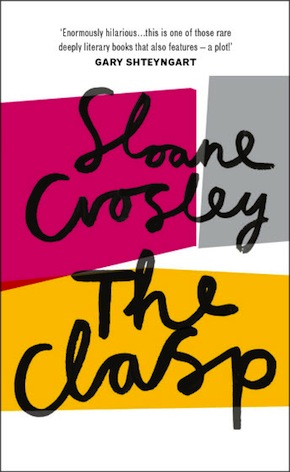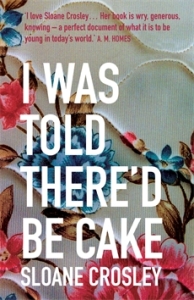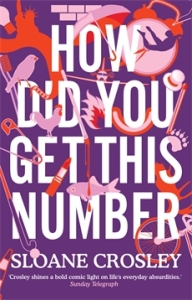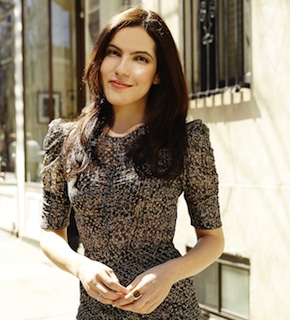Sloane Crosley: Sparkling in the dark
by Lucy Scholes
“Hilarious, insightful, and full of characters that only Sloane Crosley could devise. The Clasp is a gem.” J. Courtney Sullivan
Sloane Crosley’s debut novel The Clasp is the story of three college friends – Kezia, Victor and Nathanial – each of whom is reassessing their friendships, careers and love lives as they turn 30. Written in the style of a comedy caper, while also owing much of its inspiration to Guy de Maupassant’s famous short story ‘The Necklace’, as Crosley herself sums it up as we start chatting, it’s “like A.S. Byatt’s Possession, but funny.”
LS: I’ve heard you describe yourself elsewhere as a ‘short story fiend’. Can you tell me what it is about the genre you admire, and any stories in particular – other than ‘The Necklace’, of course?
SC: I remember being 12 or 13, and we were learning Dubliners at school. Do you remember that short story ‘Araby’? It’s the one where the guy goes to the fair and decides not to buy that vase for his next-door neighbour, an older woman he has a crush on, and when he approaches the stall, the woman serving him gives him the same beatific smile the neighbour had given him and says, “How may I help you?” And he just says, “Never mind,” and walks off. I clearly remember my teacher saying that these James Joyce stories didn’t have to mean anything; they can just be a slice of life. But that was so entirely incorrect, it’s clear that the point of the story is the woman giving him exactly the same smile, and him realising that he didn’t have the connection he thought he did with the first woman and that’s why he decides not to get her anything. It was a moment where I felt, I know this story; it’s now mine.
I probably have an even number of short-story collections to novels in my house. I’ll read them to people over the phone. If you’re my dear friend or you’re in love with me, it’s great; if you’re not, it’s probably torturous. There’s this story called ‘White Angel’ by Michael Cunningham – it ran in the New Yorker, and was the first story in the magazine to feature kids on drugs, and it’s so beautiful. It’s about two brothers in Cleveland in the ’60s, one of whom dies after running through a plate glass window by accident. It goes from being this beautiful story with all this incredible imagery about snow falling to then becoming this very bloody, visceral thing. The younger brother watches his older brother being held in his girlfriend’s arms while he’s dying, but he’s been jealous of the fact the girlfriend’s been taking his favourite person in the world away from him. The last line of the story is, “And I can’t even write her name.” And you don’t realise until then that he hasn’t named her at any point.
But you didn’t want to write short stories, you jumped right in with a novel?
I love what short stories can do, but I think of it as a very separate art form from the novel. People have asked me why I didn’t move into short stories after the essays since they’re similar, but I don’t think they are. I wanted to dive in and spend a lot of time with a single book.
If I had to choose between being described as funny or literary, I’d choose funny… and then you can make them cry when they’re not looking. That’s my thing.”
You studied English Literature and then creative writing at college, but then you worked as a publicist for Random House in New York for many years. While you were working, did you really want to be writing?
I really loved my job, so not in any obvious way, but I guess technically I was harbouring ambitions to write. But even before I was writing for the Village Voice [the first place her essays appeared] I was writing book and music reviews, and I was working on the novel I’d written in college. I hated working on that though, because I’d already finished it so I was essentially just expanding descriptions.
 What did you learn from writing that first unpublished novel? Did it teach you what to do a second time round, or what not to do?
What did you learn from writing that first unpublished novel? Did it teach you what to do a second time round, or what not to do?
Definitely more the latter. I didn’t know how to do it, but I knew what I didn’t want to do. I knew that I wanted the novel to be bigger that my previous writing, but I didn’t want it to lose the sensibilities – my sensibility – of the essays. Basically I wanted to fill a novel with things I love. I love love-triangles, I love history, literature and short stories, and I’m a huge fan of Paris. I wanted to have fun with it.
I had a real sense of enjoyment and fun while reading the novel so I’m assuming you did?
I did, but it was important that I not have it be my voice. In my two previous books I didn’t have to use that filter so it was something I had to work out. Two characters might be sitting in a coffee shop like we are, for example, and while I might notice something about the room, if they wouldn’t be the kind of people to pick up on it, I can’t mention it. That’s what was interesting for me to write, but it’s also what made it come alive too. Giving myself different restrictions, and then watching my characters blossom within that. Not that I experienced that thing where writers say their characters were writing their own dialogue. Oh, please! These people are living rent-free in my head. That’s not paying their due. It’s almost like with a cat or a dog, you just want them to say one word of English, just one word!
A lot of people have pointed out how successfully you wrote your male characters, Victor and Nathaniel, that they read as extremely believable. Did that take a huge amount of effort? How did you go about making sure you’d got them right?
That is the best compliment ever. There are compliments that I don’t like and compliments that I do.
Compliments that you don’t like? Like what?
Well, when I say don’t like, I realise that beggars can’t be choosers in the harsh literary world out there, so I’ll take anything. But basically in that first novella I wrote one of the characters dunks her head in a basin of water in a gas station restroom in the very first scene, then there’s a lake scene halfway through, and then at the very end she’s looking out over the ocean, and the professor who gave me honours for it said that he really admired my use of water imagery, and I felt like Marshall McLuhan in that scene in Annie Hall when he says, “No, you’ve got it entirely wrong!” I mean, I’ll take it, but it was absolutely unintentional, so when I say don’t like, I guess I mean didn’t earn.
For example, one of the things people keep saying is that The Clasp is capturing this millennial generation. I know how old my characters are, I very consciously give their ages – 30, 29 and 29 – because I meant to write about 30-year-olds, not 30-year-olds specifically living in 2015. So it’s funny when people say that even though I’m older, I’ve captured this younger voice. I can only think it’s because I’m massively immature; it certainly wasn’t intentional.
But saying I got men right, and two different men right, I like that because I worked hard at it. That said, I’m not sure men and women are that different. It wasn’t really that much of a stretch. I mean, I’ve met men, I’ve spoken to a few – one is my dad, I’ve had boyfriends and friends – so it’s not that hard to take a decent guess. I did give the manuscript to my friend Ethan, who’s also a writer, just in case I was horribly, horribly wrong. I asked him questions like, ‘Are they thinking about sex enough? Are they wearing the right thing?’ At one point I have someone sweating through their shirt, and I needed to know whether they’d be self-conscious about that, would they care?
Those all seem like fairly minor details, but surely it’s the little things that are important…
Well, one of the things I’ve noticed when men are writing women is that they often have their characters thinking about clothing; skirts that ‘skim’ knees, for example. I’ve never thought that about anything I’ve worn, have you? Wouldn’t that be funny if ‘skimming’ was a quality by which clothing was sold to you? A sales assistant saying, “Have you noticed how well that skims your body?” I think a lot of male writers write women like they’re on acid – it’s like they can feel the sounds, like they’ve got synesthesia.
Have you ever had an experience with someone – usually it’s a member of the opposite sex, but sometimes it’s a boss or a colleague you’re having difficulty with – where you know they have the wrong impression of you but you know you can’t change it; the more you try to the deeper you dig yourself in? In that kind of scenario I always think I wish they could just see me walking up the steps to my apartment and checking my mail; not obsessing about their texts or having to have a talk with them, none of that, just me being normal. I sort of felt that with all of these characters. Part of the challenge for me was to find empathy for them, and to produce empathy for them in the reader, especially since more than a handful of them are not likeable.
Given there are quite a few different strands to the novel, do you remember where it all began, what the first element was that caught your attention?
 A.M. Homes interviewed me about this book recently and she said, “You were a different person when you started this book.” And although it hadn’t really occurred to me, it’s true. It took me four years to write, so what I tell you now is more of an approximation than anything. I can’t remember anything more specific than that, but I do remember Victor came first. I liked the idea of writing in man’s voice, and in the third person.
A.M. Homes interviewed me about this book recently and she said, “You were a different person when you started this book.” And although it hadn’t really occurred to me, it’s true. It took me four years to write, so what I tell you now is more of an approximation than anything. I can’t remember anything more specific than that, but I do remember Victor came first. I liked the idea of writing in man’s voice, and in the third person.
As a challenge?
Yes, but also to distance it from the essays. And then I grew to really like him, I liked he wasn’t an Alpha male type. It was a bit risky in terms of making him believable because he’s a guy with a thing for shoplifting, which is usually the terrain of teenagers, and he becomes obsessed with a piece of jewellery, but he’s not effeminate.
Originally it was going to be almost a ‘he said’, ‘she said’ between him and Kezia. Then I was watching The Philadelphia Story, which is one of my favourite movies – the love triangle (though technically it’s a square but nobody ever mentions the third guy) and, of course, Jimmy Stewart, who’s my all-time celebrity crush, I just love him, it’s a real problem. Because he’s dead, among other hindrances. That could be the title of my third essay collection, He’s Dead, and Other Hindrances: Why I Can’t Make Out With Jimmy Stewart. Anyway, I loved that love triangle, so Victor and Kezia are both enthralled by Nathaniel, though in different ways, but I was missing the glue. I liked the idea of them being friends from college, and that they’re at a moment when they’re taking stock of their friendships and their careers.
This book was originally about 250 pages longer than it is now, but it becomes easier to edit once you know who your characters are. I mean, I think some people go too far – I don’t know what kind of toothpaste these people use; I mean, I think they brush their teeth, they seem hygienic – but you do get to know them. It’s also about what kind of novel you want to write.
You seem to have had a fairly good idea of what kind of novel you wanted to write even before you found the characters and plot. Did you always know you wanted it to be funny?
If I had to choose between being described as funny or literary, I’d choose funny. I feel that there are less prizes in it – comedic actresses are not winning the Oscars – but you get to do what you set out to do, which is to entertain people. And then you can make them cry when they’re not looking. I like to think my essays are the same; that they’re a little bit sad when you’re not looking. That’s my thing.
Did you have to do much research when it came to all the details about the jewellery?
Oh my god, yes! My sister works as a designer [she shows me a beautiful ring], and I also have two friends who are designers in New York. Neither of whom are Rachel [Keiza’s crazy jewellery designer boss-from-hell in the novel]. I make sure to say that in every interview, these are dear friends of mine.
I actually tried to make a line of necklaces I then never put out. I went to the Meatpacking District and learnt all about the clasps. They’re really cool. They’re made out of charge coins – these were sort of like antique credit cards, though only used in individual stores or hotels; small metal coins, all different shapes and sizes carried by customers instead of cash with personalised codes engraved on them that would then be traced onto carbon paper. They’re really hard to find in good shape, and I made sterling silver chains and everything, so the few pieces I made would be pretty pricey, but it’s a small price to pay in terms of research.
 Sloane Crosley is the author of the bestselling essay collections, I Was Told There’d Be Cake and How Did You Get This Number, and the short e-Book Up the Down Volcano. A regular contributor to the New York Times, she has also written for the Guardian, Elle, GQ and the Wall Street Journal, and been a guest lecturer at various colleges and universities including NYU and Columbia. The Clasp is published by Hutchinson in hardback and eBook.
Sloane Crosley is the author of the bestselling essay collections, I Was Told There’d Be Cake and How Did You Get This Number, and the short e-Book Up the Down Volcano. A regular contributor to the New York Times, she has also written for the Guardian, Elle, GQ and the Wall Street Journal, and been a guest lecturer at various colleges and universities including NYU and Columbia. The Clasp is published by Hutchinson in hardback and eBook.
Read more.
sloanecrosley.com
@askanyone
Lucy Scholes is a contributing editor at Bookanista and a literary critic and book reviewer for publications including the Daily Beast, the Independent, the Observer, BBC Culture and the TLS. She also teaches courses at Tate Modern, Tate Britain, the BFI and Waterstones Piccadilly.
@LucyScholes
Author portrait © Caitlin Mitchell

